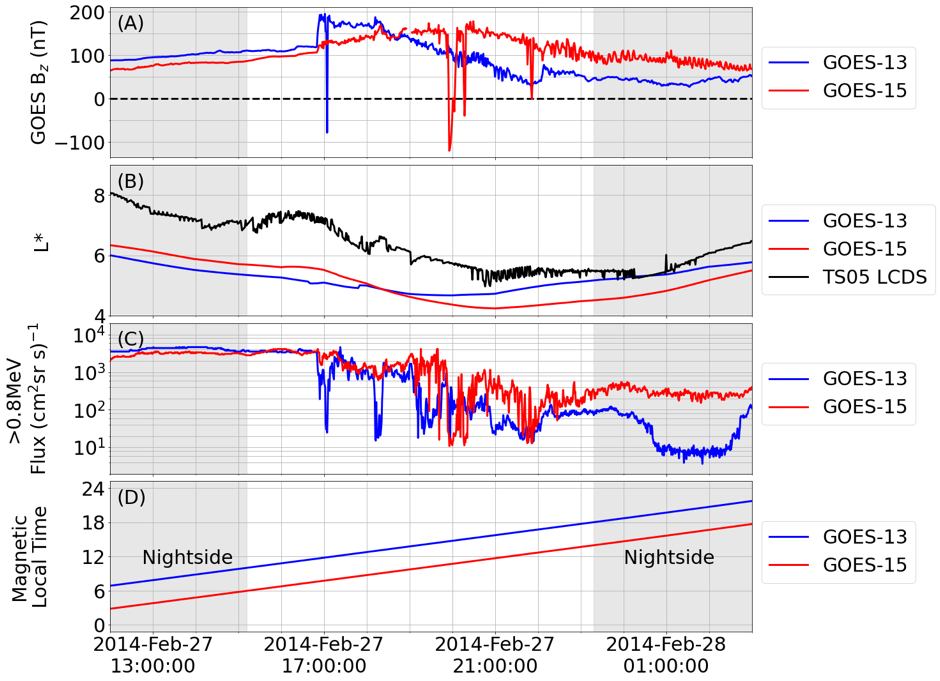MIST
Magnetosphere, Ionosphere and Solar-Terrestrial
Variations in Observations of Geosynchronous Magnetopause and Last Closed Drift Shell Crossings With Magnetic Local Time
By Tom Daggitt (British Antarctic Survey, University of Cambridge)
Geostationary satellites may cross the magnetopause during highly active times when it can be compressed inside geostationary orbit. At this time the satellite will switch from observing Earth’s magnetic field to the interplanetary magnetic field, which is usually opposing Earth’s field during compressions. The satellite will observe a drop in electron flux as it goes from measuring trapped electrons in Earth’s radiation belts to electrons in the interplanetary medium.
We compare observations from the GOES-13 and GOES-15 satellites during geomagnetic storms. We attempt to predict magnetopause crossings using models of the last closed drift shell (LCDS), the outermost stable orbit for an electron trapped in Earth’s magnetic field. The LCDS is modelled as the largest L* value that calculated by the IRBEM magnetic field modelling library (Boscher et al., 2013), using a method derived from Albert et al. (2018).
Figure 1(A) shows the Bz component of the field measured by the GOES magnetometers, demonstrating independent magnetopause crossings when the Bz component is negative. Each satellite only sees a magnetopause crossing when it is nearer local noon.
1(B) shows the satellite L* and the LCDS derived from the TS05 field model (Tsyganenko & Sitnov, 2005). Neither satellite crosses the LCDS during their magnetopause crossings, showing that brief crossings cannot be predicted with this method.
1(C) shows the >0.8MeV flux measured by the GOES satellites, showing rapid decreases in the measured flux associated with each magnetopause crossing. GOES-13 also shows a large decrease in flux as it moves into the nightside, likely due to distortion in the magnetotail.
The difference in the observed flux profiles demonstrates that choice of satellite may have a large effect when using satellite data to drive radiation belt models. Data from multiple satellites should be used to ensure constant measurements of the trapped flux on the dayside when driving radiation belt models.

References:
Boscher, D., Bourdarie, S., O’Brien, P., & Guild, T. (2013). Irbem library v4.3, 2004-2008. https://spacepy.github.io/irbempy.html.
Albert, J. M., Selesnick, R., Morley, S. K., Henderson, M. G., & Kellerman, A. (2018). Calculation of last closed drift shells for the 2013 gem radiation belt challenge events. Journal of Geophysical Research: Space Physics, 123(11), 9597– 9611. https://doi.org/10.1029/2018JA025991
Tsyganenko, N., & Sitnov, M. (2005). Modeling the dynamics of the inner magnetosphere during strong geomagnetic storms. Journal of Geophysical Research, 110(A3), A03208. https://doi.org/10.1029/2004JA010798
Associated Paper:
Daggitt, T. A., Horne, R. B., Glauert, S. A., Del Zanna, G., & Freeman, M. P. (2022). Variations in observations of geosynchronous magnetopause and last closed drift shell crossings with magnetic local time. Space Weather, 20, e2022SW003105. https://doi.org/10.1029/2022SW003105